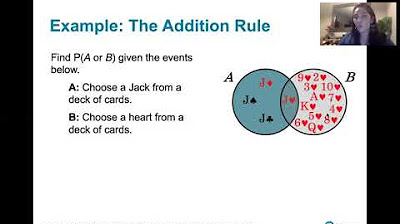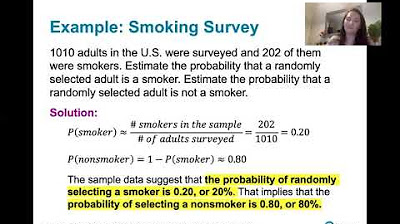Probability of Complementary Events & Sample Space
TLDRThis script explains various probability concepts through the example of rolling a six-sided die. It breaks down the sample space, event A (including outcomes less than or equal to 4), and event B (outcomes of 3, 4, and 5). Then it calculates the probability of A and B occurring, P(A or B), the P(complement of A), P(A), and P(A or complement of A), highlighting the fact that P(A) plus P(complement of A) equals 1. Finally, it calculates the probability of selecting a marble that is not red, given that the probability of selecting a red marble is 35 percent.
Takeaways
- 😊 Defining the sample space is the first step in calculating probabilities
- 👍🏻 To calculate probability: # of favorable outcomes / total # of possible outcomes
- 🧮 Reducing fractions makes probabilities easier to evaluate and compare
- 😯 Complementary events cover all non-overlapping outcomes
- 🤝 The probability of A or B = the union of their outcomes
- ❗️ P(A) + P(not A) = 1. Useful for finding complements!
- 📝 The complement formula: P(not A) = 1 - P(A)
- 🔢 Apply the complement formula when probability of an event is given
- 🎲 The sample space encapsulates all possible outcome options
- 📊 Probabilities quantify likelihood between 0 and 1
Q & A
What is the sample space when rolling a 6-sided die?
-The sample space when rolling a 6-sided die is the set of all possible outcomes {1, 2, 3, 4, 5, 6}. There are 6 total possible values the die can land on.
What numbers make up event A in the example?
-Event A includes the outcomes all natural numbers less than or equal to 4. So event A contains the numbers {1, 2, 3, 4}.
What numbers make up event B in the example?
-Event B contains the outcomes 3, 4, and 5. So event B is the set {3, 4, 5}.
How is the probability of event A and B occurring calculated?
-The probability of A and B occurring is calculated by finding the number of favorable outcomes in the intersection of A and B over the total number of possible outcomes. Here, A and B intersect at {3, 4}. There are 2 favorable outcomes out of 6 total possible outcomes. So the probability is 2/6 = 1/3.
How is the probability of event A or B occurring calculated?
-The probability of A or B occurring is found by determining the number of favorable outcomes in the union of A and B over the total outcomes. The union of A and B is {1, 2, 3, 4, 5}. There are 5 favorable outcomes out of 6 total. So the probability is 5/6.
What is the probability of getting the complement of event A?
-The complement of A contains the numbers {5, 6} from the original sample space that are not in A. There are 2 favorable outcomes for the complement. With 6 total possible outcomes, the probability is 2/6 = 1/3.
What is the useful equation relating the probability of an event and its complement?
-The equation is: P(Complement of A) = 1 - P(A). This tells us that if we know the probability of an event occurring, we can calculate the probability of its complement by subtracting from 1.
If the probability of selecting a red marble is 35%, what is the probability of selecting a marble that is NOT red?
-Since the probability of selecting a red marble is 0.35, the probability of selecting a marble that is not red (the complement) is 1 - 0.35 = 0.65. So there is a 65% chance of selecting a non-red marble.
In the example with events A and B, what is the probability of event A occurring?
-Event A contains the outcomes {1, 2, 3, 4}. There are 4 favorable outcomes out of 6 total possible outcomes. So the probability of event A occurring is 4/6 = 2/3.
What is significant about the probabilities of an event and its complement adding to 1?
-When the probability of an event plus the probability of its complement equals 1, it verifies that the entire sample space is accounted for. No outcomes were missed or double counted.
Outlines
🎲 Finding Probability of Events Using Sample Space
This paragraph explains how to find the probability of two events (A and B) occurring using sample space analysis. It provides step-by-step working to calculate the probability of A and B both occurring (1/3) and the probability of A or B occurring (5/6). It also shows how to find the probability of the complement of event A occurring.
👨🏫 Complement Probability Formula
This paragraph explains the formula for finding the probability of a complementary event - it is 1 minus the probability of the original event occurring. An example is provided calculating the probability of selecting a non-red marble given the probability of selecting a red marble is 35%.
Mindmap
Keywords
💡sample space
💡event
💡probability
💡intersection
💡union
💡complement
💡conditional probability
💡mutually exclusive
💡independent events
💡dependent events
Highlights
Let's say we want to roll a 6-sided die, and so let's write the sample space for that so we have six possible outcomes
Event A includes the outcomes all natural numbers so less than or equal to four
Event B has the outcomes three four and five
To find the probability, first write the sample space of events A and B which is the intersection
The probability formula is number of favorable outcomes divided by total number of possible outcomes
The probability of A and B is 1/3 or 33%
The probability of A or B is 5/6 or about 83%
The complement of A includes the numbers 5 and 6
The probability of getting A plus the probability of getting the complement of A equals 1
The probability of the complement is 1 minus the probability of the event
If the probability of selecting a red marble is 35%, the probability of selecting a non-red marble is 65%
The probability of selecting a non-red marble is 1 minus the probability of selecting a red marble
The probability of selecting a non-red marble is 1 - 0.35 = 0.65
There is a 65% chance of selecting a non-red marble
The probability concepts can calculate complements and apply formulas
Transcripts
Browse More Related Video

Probability Tree Diagrams

4.2.2 Addition and Multiplication Rules - The Addition Rule

4.1.3 Basics of Probability - Finding the probability of the complement of an event

Finding probability example 2 | Probability and Statistics | Khan Academy

Probability of Mutually Exclusive Events With Venn Diagrams

How to calculate p-values
5.0 / 5 (0 votes)
Thanks for rating: